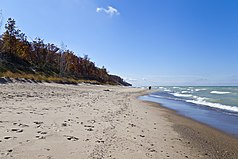Indiana Dunes National Park
| Indiana Dunes National Park | ||
|---|---|---|
|
|
||
| Location: | United States | |
| Next city: |
Beverly Shores , Porter |
|
| Surface: | 60.97 km² | |
| Founding: | 15th February 2019 | |
| Visitors: | 1,756,079 (2018) | |
| Address: | nps.gov/indu | |
| Beach on Lake Michigan | ||
The Indiana Dunes National Park (until 2019 Indiana Dunes National Lakeshore ) is a national park in the north of the state of Indiana in the United States . The park, founded on February 15, 2019, protects an area of almost 61 km² on the south coast of Lake Michigan .
geography
The national park is located in northern Indiana and is mostly in Porter County , smaller parts in Lake and LaPorte County . It is located about 50 km southeast of the city of Chicago and stretches for 15 miles along the coast between Gary and Michigan City , but is only a few kilometers wide. The park area is divided into two sections that are separated from each other. It encloses several locations as well as Indiana Dunes State Park , which is not maintained by the federal government, but by the state of Indiana. In addition, two small areas called Heron Rookery and Pinhook Bog further inland belong to the park.
climate
The climate in Indiana Dunes National Park is heavily influenced by Lake Michigan. Summers are warm, sunny and humid with maximum temperatures around 30 ° C and minimum temperatures around 18 ° C. In winter it is mostly cloudy and the maximum values are just above freezing point, while the minimum temperatures are around -5 ° C. There are about 15 days per year when temperatures are below –18 ° C (0 ° F ).
nature
Although the national park is located in a fairly densely populated area, it protects various natural spaces with over 1100 plant species. They range from dunes to oak savannahs , swamps and moorlands to grass , rivers and forests . Behind the beaches rise up to 60 meters high sand dunes, between which mostly wetlands extend in the valleys . The landscape was created by the retreat of the last continental glacier about 14,000 years ago, and at least four chains of dunes show different levels of the historic shoreline of Lake Michigan.
flora
Among the approximately 1,130 plant species found in Indiana, about 30% are listed as rare, threatened or endangered, such as the pitcher's thistle ( Cirsium pitcheri ). The dune landscape represents a demarcated area of various plants that are otherwise found in the deciduous forests of the eastern United States, boreal forests, or often on the Atlantic coast . The area is still one of the easternmost limits of the high grass prairie .
fauna
Due to the variety of different habitats in a relatively small area, the national park is rich in wildlife. There are 46 species of mammals , 18 different amphibians , 23 reptiles , 71 fish species , 60 butterfly species as well as 60 different upper and damselflies species. There are also 352 species of birds . The largest predator is the coyote , while the largest herbivore is the white-tailed deer . Because of its location on the southern tip of Lake Michigan, the Indiana Dunes are an important feeding and resting place for migratory birds.
tourism
In 2018, the park , which at that time was still a National Lakeshore , recorded a total of 1,756,079 visitors. In addition to 24 kilometers of coastline, there are over 80 kilometers of hiking trails, which are maintained in 14 routes of various lengths and degrees of difficulty. In addition to recreational opportunities in the nature, the area includes about 60 historic structures, including the National Historic Landmark explained Joseph Bailly Homestead .
Web links
Individual evidence
- ↑ a b Basic Information , nps.gov, accessed on August 9, 2019 (English)
- ↑ Weather , nps.gov, accessed August 9, 2019
- ↑ a b c Nature & Science , nps.gov, accessed on August 9, 2019 (English)
- ↑ Plants , nps.gov, accessed on August 9, 2019 (English)
- ↑ Animals , nps.gov, accessed August 9, 2019
- ↑ Stats Report Viewer , irma.nps.gov, accessed on August 10, 2019 (English)
- ↑ Hiking at Indiana Dunes National Park , nps.gov, accessed on August 10, 2019.
- ↑ Historical Sites at Indiana Dunes National Park , nps.gov, accessed August 10, 2019.




